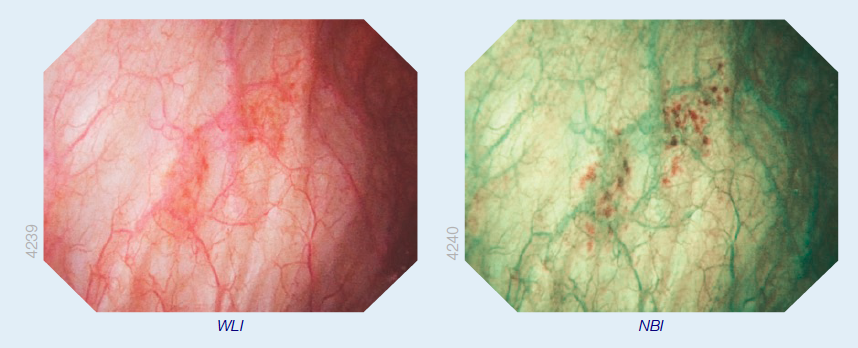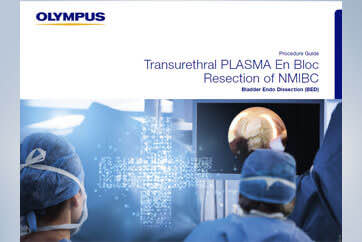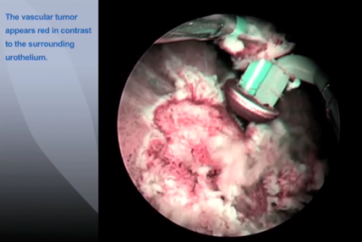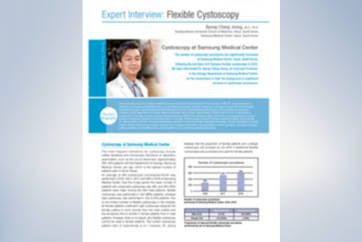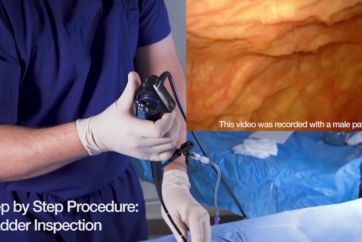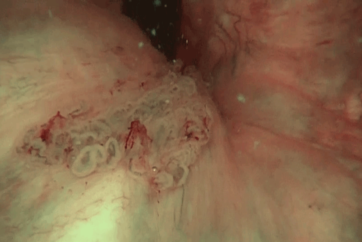NBI – PROVEN FOR BETTER CLINICAL OUTCOMES
Narrow Band Imaging (NBI) opens new therapeutic and diagnostic possibilities that support and improve a urologist’s ability to provide an early precise optical diagnosis of bladder tumors, such as non-muscle invasive bladder cancer (NMIBC). About 50–70% of patients suffer from recurrent superficial bladder tumors after their initial treatment1. Small papillary tumors, or carcinoma in situ (CIS), are missed at an estimated rate of 10 to 20%2.
NBI is a patented and unique optical filter technology that greatly enhances the visibility of vascular and mucosal
structures in the bladder using only those wavelengths highly absorbed by hemoglobin. That is why NBI
achieves maximum contrast, thus revealing significantly more details of the examined tissue than white-light
imaging (WLI) cystoscopy.
It has been clinically proven that by using NBI during procedures, more superficial tumors of the bladder
mucosa are diagnosed than when using WLI. That ultimately leads to reduced recurrence rates3.
INCREASE DETECTION, REDUCE RECURRENCE
A better view of superficial structures provides urologists with the strongest impact on improving the detection rate of superficial bladder tumors.
With NBI, it is simply easier to identify the malign structures of NMIBC and other small tumors. This has a direct
impact on patient outcomes: Compared to WLI, NBI visualizes 28% more CIS4, and detects bladder cancer in
17% additional patients4. Furthermore, NBI reduces the risk of recurrence to 17% at one year3.

Practical Benefits
- Available at a push of a button
- No preparation time needed
- No additional procedure costs
NBI – The Main Practical Benefits
- NBI is a patented filter technology that uses only blue and green light, thus creating a significantly highercontrast between blood vessels and the surrounding tissue than WLI.
- Because NBI is a purely optical system, it does not need any installation and therefore no time-consumingpreparation time.
- NBI is available with every Olympus Imaging System at a push of a button and therefore generates noadditional procedure costs.
NBI – THE SCIENTIFIC EVALUATION
NBI in International Guidelines
Numerous international specialist associations and institutes such as EAU, NICE, and AUA have commented on the use of NBI for the diagnosis and therapy of NMIBC in their guidelines.
NBI is Clinically Proven
A growing number of studies show that optical diagnosis with NBI improves lesion detection in the bladder, resulting in several clinical advantages for patient care. The different study outcomes are presented below.
In narrow-band imaging (NBI), the contrast between normal urothelium and hypervascular cancer tissue is enhanced. Initial studies have demonstrated improved cancer detection by NBI-guided biopsies and resection.
European Association of Urology (EAU)5
For diagnosing and staging bladder cancer, the guidelines recommend offering white-light-guided TUR-BT with one of photodynamic diagnosis, narrow-band imaging … to people with suspected bladder cancer.
National Institute for Health and Care Excellence (NICE)6
In a patient with NMIBC, a clinician may consider use of NBI to increase detection and decrease recurrence. Furthermore, enhanced cystoscopic techniques, including blue light cystoscopy (BLC) and narrow-band imaging (NBI), seem particularly valuable for diagnosis of urothelial carcinoma in the setting of positive cytology but negative white light cystoscopy (WLC).
American Urological Association (AUA)7
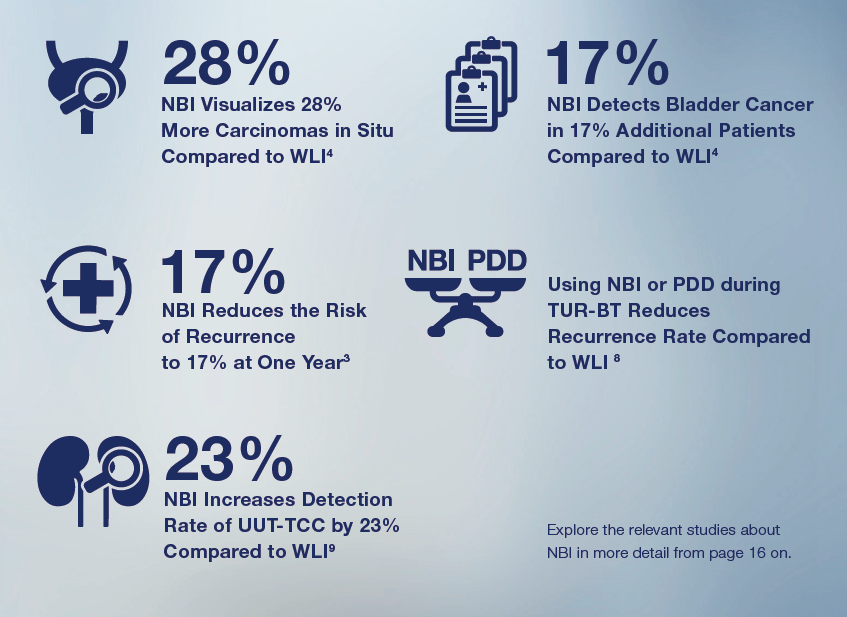
NBI – FOR VARIOUS ENDOUROLOGICAL PROCEDURES
NBI opens possibilities that support and improve the ability to provide an early precise diagnosis of bladder and upper urinary tract tumors.
Flexible Cystoscopy
Flexible cystoscopy either for early diagnosis or follow-up procedures can be performed using NBI in the outpatient setting. It is clinically proven that NBI diagnoses more bladder cancer compared to WLI.
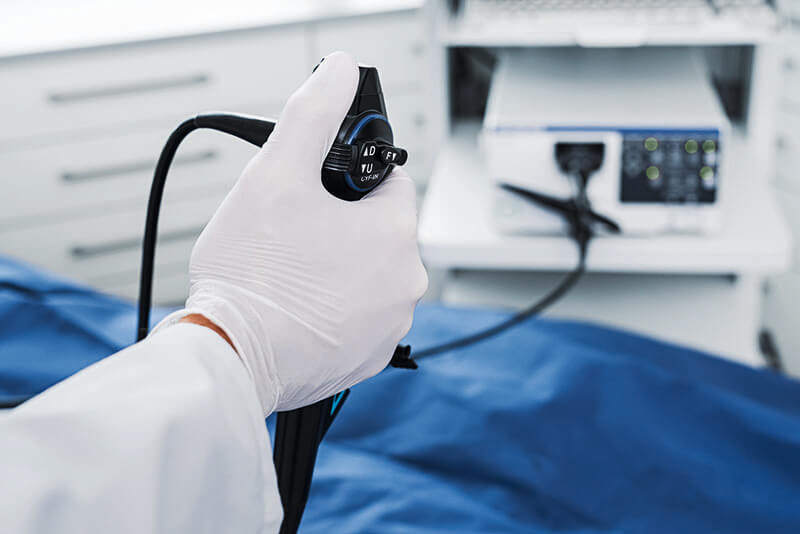
Related Products
- CV-170
Imaging system - CYF-VH
Flexible video cystoscope
Flexible Ureteroscopy
Flexible ureteroscopy for urinary tract tumor visualization can be performed using NBI in the operating room. It is clinically proven that NBI improves the UUT-TCC detection rate compared to WLI.

Related Products
- VISERA ELITE II
Imaging system - URF-V2
Flexible video ureteroscope
When using NBI while performing transurethral resection of bladder tumor (TUR-BT), diagnosis and PLASMA therapy of NMIBC can be done simultaneously. The combination of the two technologies NBI and PLASMA during TUR-BT – leads to an optimal clinical outcome.
TUR-BT
NBI and PLASMA can be used to diagnose and treat NMIBC. With NBI, lesion limits can be visualized better.
This allows in the first step precise marking, as well as even the complete resection of the bladder tumor using the PLASMA technology.
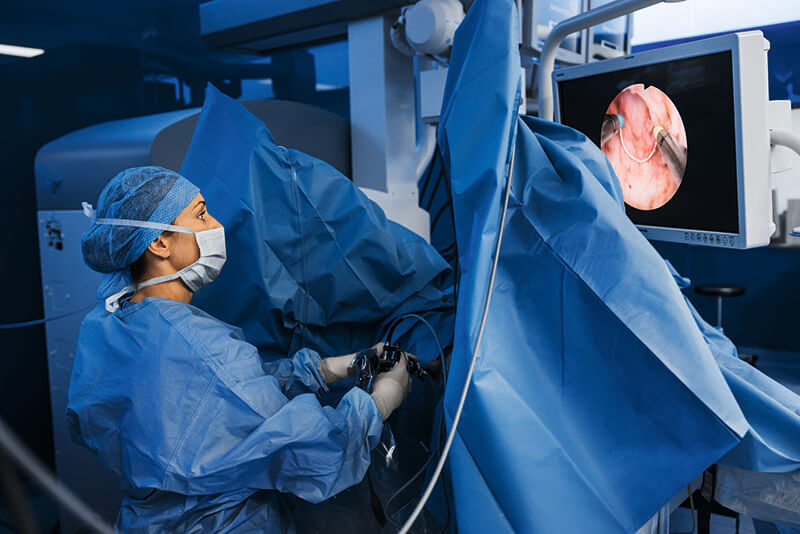
Related Products
- VISERA ELITE II
Imaging system - OES Pro
Resectoscope - PLASMA Electrodes
Various procedure-specific electrodes for conventional and en bloc resection
With NBI I can make a safer diagnosis, I can simply see better what the patient has.
Prof. Jørgen Bjerggaard Jensen
Department of Urology at Aarhus University Hospital
Chairman of the Danish Bladder Cancer Group
NBI – THE SAFE SOLUTION FOR EARLY NMIBC DETECTION
NBI allows urologists to diagnose and treat bladder cancer even more precisely and reliably. It is clinically proven that by using NBI, urologists detect more cancer lesions than by using WLI. In addition, NBI is easy to handle and cost-effective. Combining all this, NBI is a safe way to improve the clinical outcomes in patients with suspected bladder cancer.

Clinically Proven
Numerous studies, including a growing number of randomized clinical trials (RCTs) and meta-analyses, highlight the clinical value of NBI, especially with regard to the detection of bladder cancer and the recurrence risk. The results of these studies show that the use of NBI has several clinical benefits for patient outcome compared to WLI, while there are no contraindications for the use of NBI. NBI detects NMIBC in 17% additional patients4, visualizes 28% more CIS4, and increases the rate of UUT-TCC lesion detection in the kidney. Furthermore, it reduces the risk of recurrence to 17% at one year when used during a TUR-BT3.
Cost-Effective
There are no extra costs with NBI, as no additional installations or disposable items are required. Olympus Imaging Systems automatically feature NBI, so there is no extra cost per procedure. By improving the visibility of vascular and mucosal structures in the bladder, NBI supports and improves a urologist’s ability to provide an early precise optical diagnosis of bladder tumors, which is likely to have positive cost effects.
High Versatility
NBI can be used during various endourological procedures such as TUR-BT, flexible cystoscopy, and flexible ureteroscopy. NBI is available for the Olympus VISERA ELITE II imaging system and combined with either OES Pro resectoscope or URF-V2 flexible video ureteroscope in the operating room, and with the Olympus CV-170 imaging system and the CYF-VH flexible video cystoscope for diagnostic examinations in outpatient settings.
Easy Handling
Using NBI requires no time-consuming preparation or installation prior to performing procedures like flexible cystoscopy, flexible ureteroscopy, or TUR-BT. NBI is available for the latest Olympus Imaging Systems, and it can easily be switched on by a push of a button.

One of the great advantages of NBI is that it helps me to detect CIS. It is very important to make sure that the first diagnosis is correct.
With NBI, the number of biopsies and therefore false positive results is much lower than with PDD. That too, reduces the inconvenience for my patients.
Prof. Jørgen Bjerggaard Jensen
Department of Urology at Aarhus University Hospital
Chairman of the Danish Bladder Cancer Group
- Content Type

